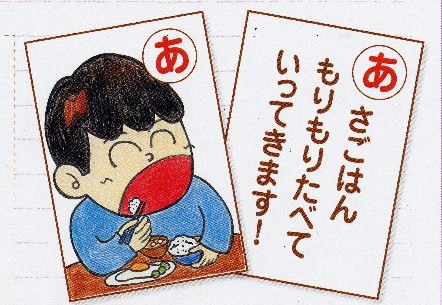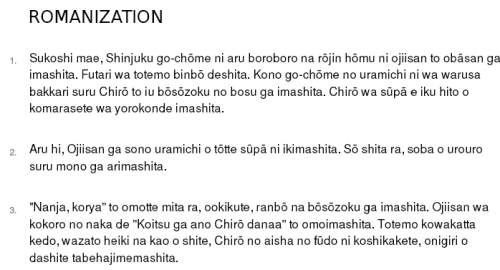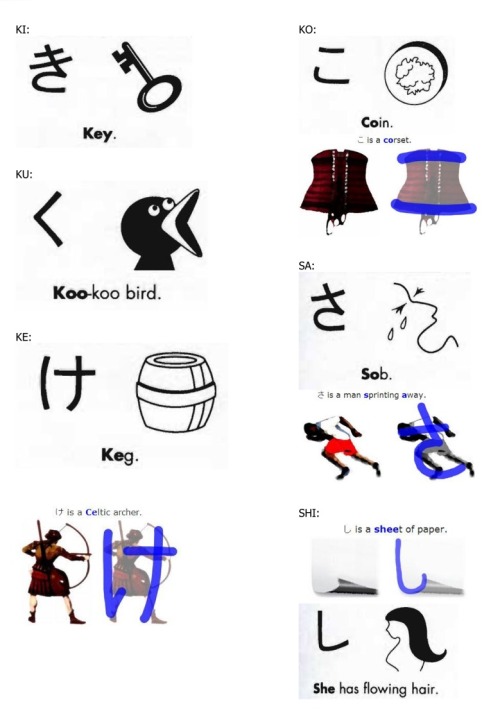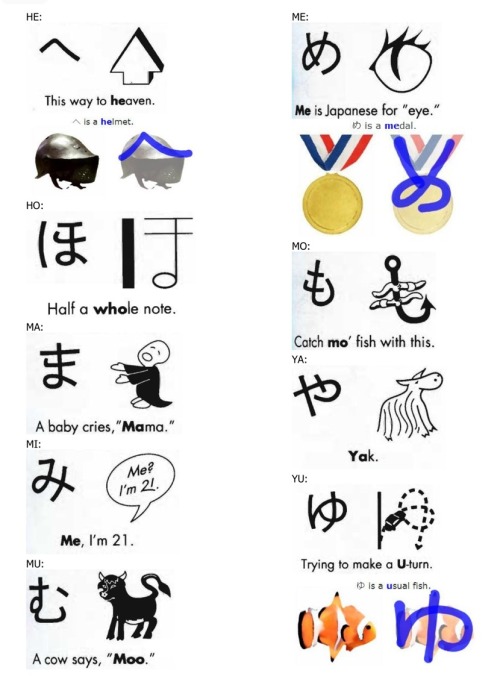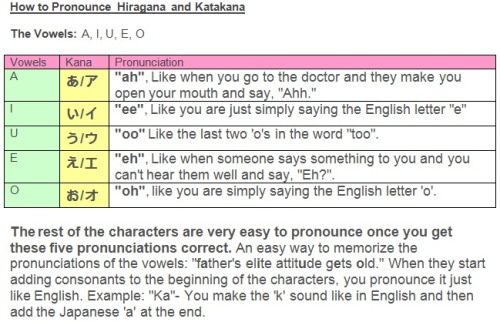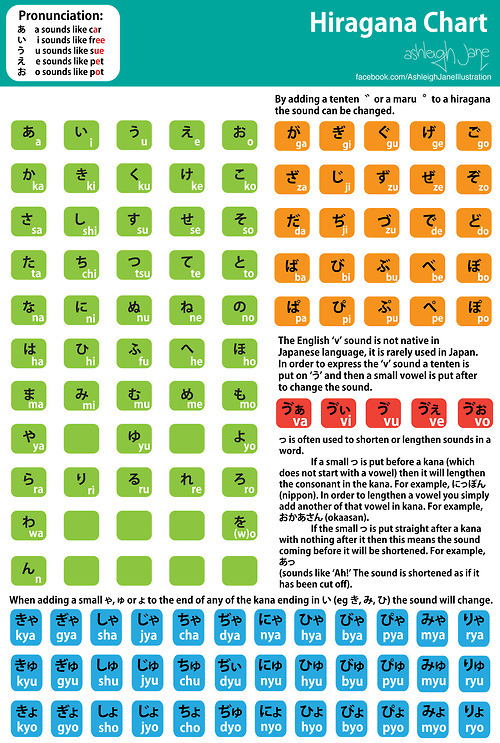#japanese alphabet
How to use ANKI (Flashcard program)
Currently using it to do 10 kana a day, then 30 kanji a day for the next 3 months.
How to Write Hiragana & Katakana Step By Step:
Hiragana:
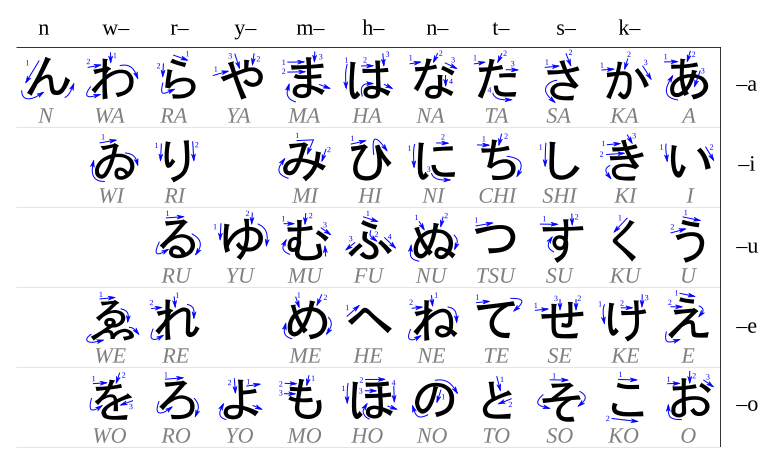
Katakana:
For animation of each and quizzes check out these links
HIragana stroke order animated chart

Check out these 2 videos to explain how each writing system is used. (Might have to open this post in a browser instead of the tumblr app.)
Why romaji is confusing…
Learning Japanese: (1) Alphabet and Pronunciation
Hiragana & Katakana Mnemonics
Remember the order: A KindSamuraiTrainedNinjasHelpingManyYoungRookiesWithNunchucks
Check out Remembering the Kana by Heisig
Also check out this Hiragana Mnemonic pdf by Tofugu
Post link
Learning Japanese: (1) Alphabet and Pronunciation
Part 1A: Kana sounds
Japanese pronunciation notes:
- Consonants are pronounced like the English letter sound, except for ‘R’ which is pronounced between an 'L’ and an 'R’.
- Double vowels (aa, ii, uu, ee, oo) are pronounced twice as long as the single vowel.
- Don’t say the characters in your head, say them out loud so you can get more speaking practice.
- Memorize the Kana symbols with vivid pictures. For instance; き “ki” looks and sounds similar to “key”.
- If you’re going to Japan, take some time out to learn about their body/hand gestures too! Actions speak louder than words and some body/hand gestures that are okay in your country may not be okay or polite in Japan. If you do something that does offend someone, just apologize to them.
HIRAGANA NOTES:
- The hiragana syllabary is used to write word endings and Japanese words, replacing the kanji if the kanji is not widely known or the readers are children. It can also be used alongside kanji to indicate its pronunciation.
- When there is a “little tsu”(つ) inside a word (ie. きった), it means that the consonant of the next syllable is doubled. For instance, きった is kitta (“keet-tah”) and means “cut” as in “cut the cake”, whereas きた is kita (“keetah”) and means “north”.
- The vowels i and u are often silent or barely pronounced in most Japanese words, especially when they are located at the end of certain verbs. It is also the case of the vowel “u” that follows the consonant “s”. For example, “arimasu” (there is) is pronounced “ah-ree-mas”, “deshita” (was) is pronounced “deh-shtah”, and “suki” (to like) is pronounced “skee”.
- Romanized Japanese words with ō translate as ou, or おう
- When は,をandへ are used as sentence particles, they are respectively pronounced wa (“wah”), o (“oh”) and e (“eh”)…particle lessons later (stay focused on your current task)
KATAKANA NOTES:
- The katakana syllabary is used to write a word borrowed from a foreign language, as well as all foreign names and onomatopoeia. It can also be use for emphasis, similar to using bold or italic text in English.
- In katakana, the character (ー) is used to double the vowel of the preceding character. For instance, the word “game” uses katakana characters for being a foreign word, and is written “ゲーム" : "geehmu” (the final u is barely pronounced).
Post link
Learning Japanese: (1) Alphabet and Pronunciation
Part 1A: Kana sounds
Here is a cute Hiragana and Katakana song
It’s time to begin our Japanese learning plan
Step 1: Learn the alphabet and correct pronunciation
- To do: (1) learn 10 kana a day (reading, writing, pronunciation, usage), (2) listen to native Japanese speakers and shadow their sounds for better pronunciation. Listen to the news, real life stuff not anime. Unless you want to sound cartoony. After you get the correct sound down then feel free to go watch your favorite anime.
- Time limit: 2 weeks- 1 month
“The Alphabet"
The Japanese language has 3 writing systems:
- Kana are the syllabic Japanese scripts. There are two kana scripts: hiraganaandkatakana. Japanese children start to read and write in hiragana before making an attempt to learn some of the two thousand kanji commonly used.
Hiragana are sometimes used to write words which would normally written with katakana to make them appear more “feminine”, particularly in comic books and cartoons for young girls. In children’s video games texts are often written entirely in hiragana or katakana.
- Kanji are ideograms, i.e. each character has its own meaning and corresponds to a word.
Japanese is sometimes written in Romaji. Romaji is primarily used for the convenience of foreigners. With Romaji, one can read Japanese without knowing any Japanese writing system. Although there are several systems of Romaji, the most widely used is a modified Hepburn system.
How many kana are there?
46 (basic set-green), 36 (combined-blue), 25 (dakuten-orange)= 107 each
So to learn 214 kana doing 10 a day=21.4 days (22 days)
Or if you just focus on the basic set you would be done in about 10 days. Look at the chart and you will see the combined and dakuten are just variations of the basic set.
However you want to learn it is on you. But I want to complete this in 2 weeks. Feel free to use mnemonics and flashcards (widely used program is ANKI)
————————————————————————————
Check point:
- Can you identifyall the hiragana and katakana
- Can you writethem all?
- Can you pronouncethem all?
- Can you translate kana to romaji and vice versa? (side note: once you understand kana don’t use romaji – use your kana- Tell you why later…)
- Can you read a passage in kana or with kanji but with furigana on top. Furigana is the small kana above a kanji to help read.
If you cleared this level move to the next one…Meet the Kanji! Don’t cry.
-Nisha
Post link
Note to self: I am resuming my Japanese studying. I studied 3 semesters in college then did a year long study abroad in Japan. I came back and I’ve done nothing with it but waste it. I get asked so many times are “you fluent in Japanese?” or comments like “you went to Japan right so can’t you speak it.” Even in a dream I had someone ask me questions in Japanese and I couldn’t answer. I woke up and thought well this is a problem. So now I’m here trying to fix it. I want to study and do it as effective and efficient as possible. I spent the week researching efficient language learning and here is the plan I came up with…(see that lovely chart I made)
With that said…Its Japanese study time. Hardcore training will commence April 2014. Hope this all goes according to plan. In the mean time I’ll be gathering resources.
-Nisha
Post link



